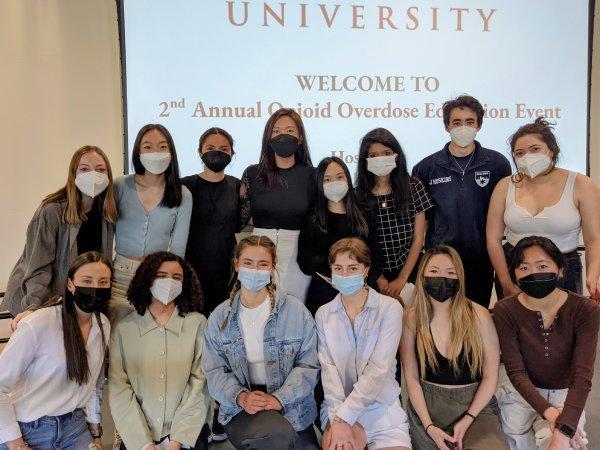
Power in Education and Prevention
Public Health capstone students under Professor Jamie Chang fight the rising issue of fentanyl laced pills through harm reduction education in the SCU community.
By Catherine Joy '23
“Doctors and rehabilitation staff around the world are scared to death… it’s never been this bad,” warns Ed Ternan, the father of Charlie Ternan, a late Santa Clara University student who passed away three weeks before his graduation in May 2020 after taking a counterfeit fentanyl pill.
Fentanyl-laced pills and accidental drug overdose is an increasingly pressing issue, and one that has directly affected our Bronco community. Professor Jamie Chang’s senior Public Health capstone students took note of this last quarter and organized SCU’s 2nd Annual Opioid Overdose Prevention event. The class partnered with the Cowell Center, Santa Clara County Opioid Overdose Prevention Project (SCCOOPP), and the non-profit overdose education organization Song for Charlie, founded by the parents of Charlie Ternan.
“The event was an important one to hold in light of the surge in fentanyl related deaths in the Bay,” says Kayley Phillips ’22, a student in the capstone group. They presented research on opioid use among college students, the rise of fentanyl, and harm reduction strategies. In addition, they also explained how to administer Naloxone (Narcan)—a medication that rapidly reverses opioid overdose— as well as how to use fentanyl test strips—a preventative step to detect fentanyl before consuming an unknown drug. “After the event, several students who had previously never heard of naloxone shared that they now felt confident to use it in an emergency,” Maddy Hatch ’22, another student of Professor Chang, explains. The event’s two sessions were able to distribute over two hundred naloxone kits to students, faculty, and staff. Additionally, SCU’s Cowell Health Center now has naloxone on hand for students to obtain.
“My education in Public Health has taught me that there is power in education and prevention,” Phillips says. “Naloxone education and its distribution will no doubt save lives.” The event’s Naloxone distribution is predicted to save at least one life in the Santa Clara community, while instilling a framework to continue the education of students and increase awareness about fentanyl related deaths. “It is not enough to remain dependent on emergency services and luck,” Phillips continued. “With an uptake in fentanyl cases, it is paramount that public health initiatives aim to save lives by preparing the greater population to respond to overdose.”
The project was chosen and guided by Jamie Chang, an assistant professor of Public Health at SCU. “I’m so glad I got to work with Dr. Chang,” Hatch says. “She cares so much about her students and is incredibly passionate about her work.” Chang provided input on the student’s research and what should be presented during the event, as well as reaching out to different communities for partnership and promotion beforehand.
“It was really rewarding to see so many people interested in learning more about opioid overdose prevention, and knowing that we’ve helped make naloxone more accessible to the SCU community,” Hatch explains. The event has since sparked further conversations about Naloxone on campus, and a much wider distribution of the medication among the student body.
Public Health capstone students and the event’s partners encourage the Bronco community to utilize fentanyl test strips on any pills they plan to take, tell someone when they plan to take a drug, and “just say KNOW,”—know about the drug being taken and any potential risks that come with it. With the continued efforts of our students, faculty, staff and community to raise awareness about harm reduction strategies, events like this can increase education about the issue and can make a tangible difference in our fights against the fentanyl crisis.